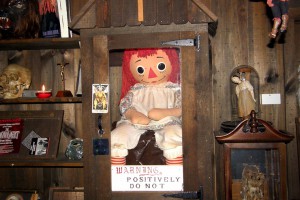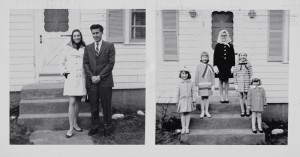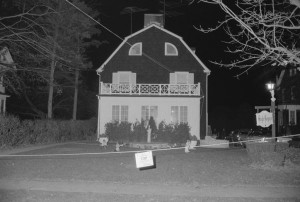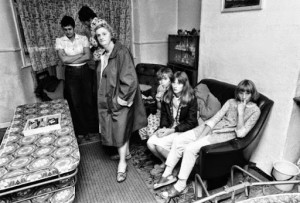Ed and Lorraine Warren: real people and cases
Edward and Lorraine Warren

Ed and Lorraine Warren are among the most famous paranormal investigators of the 20th century. Thanks to the Warner Bros. franchise and director James Wan, they have made a strong mark on today's younger generation who crave horror-themed films. And, of course, what could be closer to this theme than a profession that aims to help people from the ghosts and demons that terrorize them in their dwellings.
Edward Warren Miney was born on September 7, 1926. He was self-taught from a young age. He did not need any theological or other training to investigate the paranormal; he came to everything on his own. And he also called himself a "demonologist". Among other things, it was he who was in charge of all publicity, lectures and authorship, in the New England Society for Psychic Research (NESPR), which he and his wife founded in 1952. With his death on August 23, 2006, a fruitful part of history for the Society comes to an end.
Lorraine Rita Warren (née Moran) was born on January 31, 1927. From a young age, she claimed clairvoyance and light trance, with which she reportedly tapped into the spiritual realm to help her husband solve the most perplexing problems of their careers. After her husband's death, Lorraine continued to work for NESPR, but never again as she had during Ed's lifetime. She passed away on April 18, 2019, during the era of their greatest fame from newly produced films styled after their careers.
Warren Family Cases
Even during Ed's lifetime, both spouses proclaimed to have been behind the solution of over 10,000 paranormal cases. Always taking a primarily esoteric approach. While NESPR states that many experts were also behind their investigations, the focus of everything was purely subjective, feeling-based investigations. With all the pluses and minuses that entails.
A number of now famous ghost horror movies were directly inspired by their books or articles about some of these investigations. We'll list the most famous ones below that you may have seen in the movie version. But we'll focus more on the actual background.
The Annabelle case
According to different sources, there are two different dates for the beginning of this investigation. The first refers to 1968, the second to 1970. However, the content is the same: the Warrens were approached by two students claiming that their doll Raggedy Ann was possessed by the spirit of a young girl named Annabelle Higgins. The doll was said to be able to move on its own. After examining the doll, the Warrens were told that an "inhuman presence" was moving the doll. Raggedy Ann was then taken away and placed in a glass case in their occult museum in Monroe.
From the movies about this doll, you would think there were a significant number of dead people around her. But there's no valid source to confirm that. So the whole background behind Annabelle is probably really as ordinary as you can read in the previous paragraph.

The case of the Perron family
A case from the early 1970s that took place on a Rhode Island farm built in the 18th century. Yes, it's the case from the first movie, Demon Captive.
The Perron family still lives in this house today. And according to them, the Warrens actually helped them.
What was supposed to happen here? According to Lorraine Warren, the family was haunted by several ghosts, the most dangerous of which belonged to a witch who even possessed several members of the family.
On the film itself, the Perrons commented that it was a beautiful tapestry with many elements of truth and some moments of fiction. However, from the point of view of neuroscientist Steven Novello of the New England Skeptical Society, it is just fiction and a well-told horror story.

The Amityville case
One of the Warren family's most famous cases. In 1975, husband and wife George and Kathy Lutz claimed that their house was haunted by a violent demonic presence so intense that it drove them from their home.
A year before the Lutz's moved into the house, Ronald DeFeo, a troubled and drug-addicted young man, shot and killed six members of his family.
The Werrens' conclusions were clear: the house was haunted. Again, they published a book about it, and the whole story soon caught on with DeFeo himself, who wanted to extract a reduction or commutation of his sentence. Without success.
Several movies have been made about Amityville. The first in 1979, and others followed.
The whole case was investigated several times. However, for the police officers themselves, the murder itself was so strongly evidential that supernatural phenomena could not be mentioned.
The full stop, and the biggest blow to the Warrens, then, came with the statement by lawyer William Weber that he, Jay Anson, and the Lutz family had concocted the entire horror story over "many bottles of wine."

The Case of the Enfield Poltergeist
A very interesting investigation in terms of what the film depicts and what actually happened.
The story is depicted in the second film, Captive of Demons.
In 1977, a family in the North London suburb of Enfield was about to experience a powerful poltergeist haunting. The whole case became a media sensation, even though many eyewitnesses denied the haunting itself, stating that it was a hoax orchestrated by children. The Warrens were convinced it was a case of demonic possession. And then... reality and the film diverge sharply.
Guy Lyon Playfair, the parapsychologist who investigated the Enfield case, along with Maurice Gros, stated, after watching the sequel to Captive of Demons, that the Warrens appeared on the doorstep of the Enfield house only once. Ed communicated that they could make a lot of money on the case, whereupon they were turned away from the door and never showed up again. That was the only contact that was ever made with them there.
This version of Playfair is corroborated by other eyewitnesses, including the family involved themselves. Later investigations then gave the sceptics the benefit of the doubt when one of the girls confessed in adulthood to making up the haunting and, when such a show was made about it, was afraid to tell the whole truth.

The Arne Johnson case
Background for the third film in the Captive Demons series.
In 1981, Arne Cheyenne Johnson was accused of murdering his landlord Alan Bono. Prior to this act of violence, Ed and Lorraine Warren were called in to investigate the alleged demonic possession of Johnson's fiancée's younger brother. After the murder, the Warrens then claimed that Arne Johnson, like his brother, was possessed and therefore not responsible for the murder. Johnson took advantage of this in court and tried to plead not guilty, but failed. He was sentenced to five years.
The case surrounding Arne Cheyenne Johnson is now famous for being the first attempt in the US court system to defend murder by possession by an alien entity, or demon.
Everything else you see in the film is gravy and the writers' own invention. Here again, the truth is hidden within the confines of the real world.
Conclusion
From the above facts, we sort out the myths and facts surrounding the Warrens. What can we conclude from them?
First of all, quite undisguisedly, that Ed and Lorraine were great storytellers who could speak and write. It was through their words that the whole fiction and aura of the investigation, full of dangerous paranormal phenomena, ghosts and demons, could be created.
However, even critics who knew Ed personally pointed out during his lifetime that he liked to exaggerate. Lorraine, too, certainly interpreted her feelings more epically than the reality came to the other witnesses present. But that doesn't mean that everything they investigated was a hoax and they never picked up anything paranormal. They most certainly witnessed many mysterious things as well, but because of their often overly epic interpretations, it's hard to separate what was fiction and what is truly fact without embellishment today.
Today, what is told about the Warren investigation is a kind of second life to their work. Work that they actually did all their lives, but which often went quite differently from how it is remembered. The same can then be said of the personalities of the investigators themselves. How we see them in the film is one thing. Only witnesses who knew them personally can confirm what they were like in reality.
Nevertheless, they deserve glory and honour. They were one of the few in the field of mystery to make the field famous like no other and draw many fans closer to an interest in the world that is hidden from our senses.
Author Ondřej Bezouška
Sources of information:
- "Obituary of ed Warren | Abriola Parkview Funeral Home".
- ^ "Lorraine Warren, Paranormal Investigator Portrayed in 'The Conjuring,' Dies at 92". The New York Times. 19 August 2019.
- ^ "Obituary of Ed Warren". Abriola Parkview Funeral Home. 26 August 2006. Retrieved September 3, 2021.
- ^ Birk, Libby (April 19, 2019). "How Did Lorraine Warren Die?". PopCulture.com. Retrieved April 21, 2019.
- ^ Brown, Alan (September 30, 2008). Ghost Hunters of New England. Lebanon, New Hampshire: University Press of New England. p. 3.
- ^ "Paranormal Investigator Lorraine Warren Dies At 92". Outlook India. 20 April 2019.
- Radford, Benjamin. "The Amityville Horror". Urban Legends Reference Pages. Snopes.com. Retrieved October 25, 2011.
- McLoughlin, Pam (October 5, 2014). "Real 'Annabelle' story shared by Lorraine Warren at Milford's Lauralton Hall". New Haven Register. Retrieved 24 February2015.
- ^ Jump up to:a b Elsworth, Peter (July 17, 2013). "'The Conjuring' depicts family's reported haunting in Burrillville farmhouse in '70s". The Providence Journal. Retrieved July 21, 2013.
- ^ Alexander, Bryan (July 22, 2013). "The 'true' story behind 'The Conjuring'". USA Today. Retrieved August 5, 2013.
- ^ Downes, Lawrence (April 14, 2005). "Editorial Observer; The Devil We Know on the Island We Love". New York Times. Retrieved August 17, 2011.
- ^ Associated Press (July 27, 1979). "'Amityville Horror 'amplified over bottles of wine' – lawyer". Lakeland Ledger. Retrieved October 25, 2011.
- ^ Nickell, Joe (2012). The Science of Ghosts: Searching for Spirits of the Dead. Prometheus Books. pp. 281–. ISBN 978-1-61614-586-6.
- ^ Hawkes, Rebecca (12 May 2015). "What did the Enfield Haunting have to do with Ed and Lorraine Warren?". The Telegraph. The Daily Telegraph. Retrieved 4 September 2016.
- ^ Conjuring 2 vs the True Story of the Enfield Haunting Historyvshollywood.com
- ^ Lyon Playfair, Guy (1980). This House Is Haunted: The True Story of a Poltergeist. Stein and Day. ISBN 978-0-7387-1867-5.
- ^ Newkirk, Greg (1 July 2016). "Conjuring the Truth: Enfield Poltergeist Investigator Says Ed and Lorraine Warren Never Investigated Case". Week in Weird.
- ^ "MonsterTalk – The Enfield Poltergeist, interview with Guy Lyon Playfair". MonsterTalk. 8 March 2017. Retrieved 21 April 2021.
- ^ Lynne Baranski (October 26, 1981). "In a Connecticut Murder Trial, Will (demonic) Possession Prove Nine-Tenths of the Law?". People Magazine. Retrieved August 17, 2008.
- ^ Radford, Ben (2017). Investigating Ghosts: The Scientific Search for Spirits. Corrales, New Mexico: Rhombus Publishing Company. p. 201. ISBN 978-0-936455-16-7.
- 7 paranormal investigations by Ed and Lorraine Warren of 'The Conjuring' fame (2021), Andrew DaRosa, online <https://www.ctpost.com/entertainment/slideshow/ed-lorraine-warren-cases-the-conjuring-222531.php>

